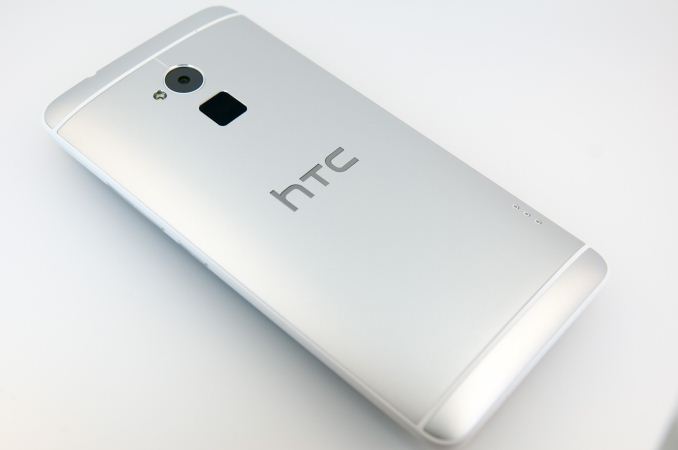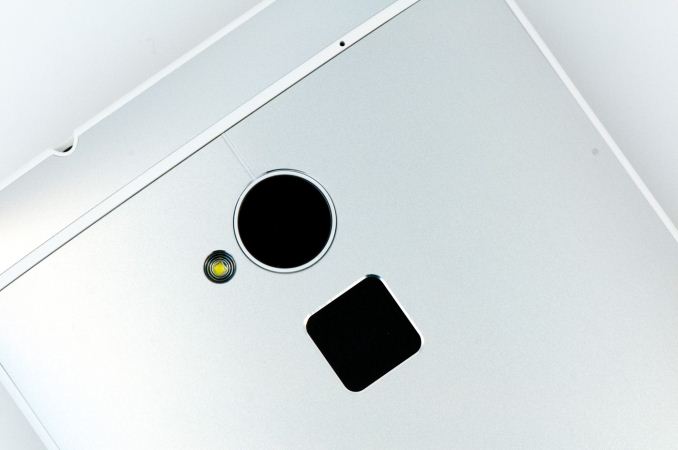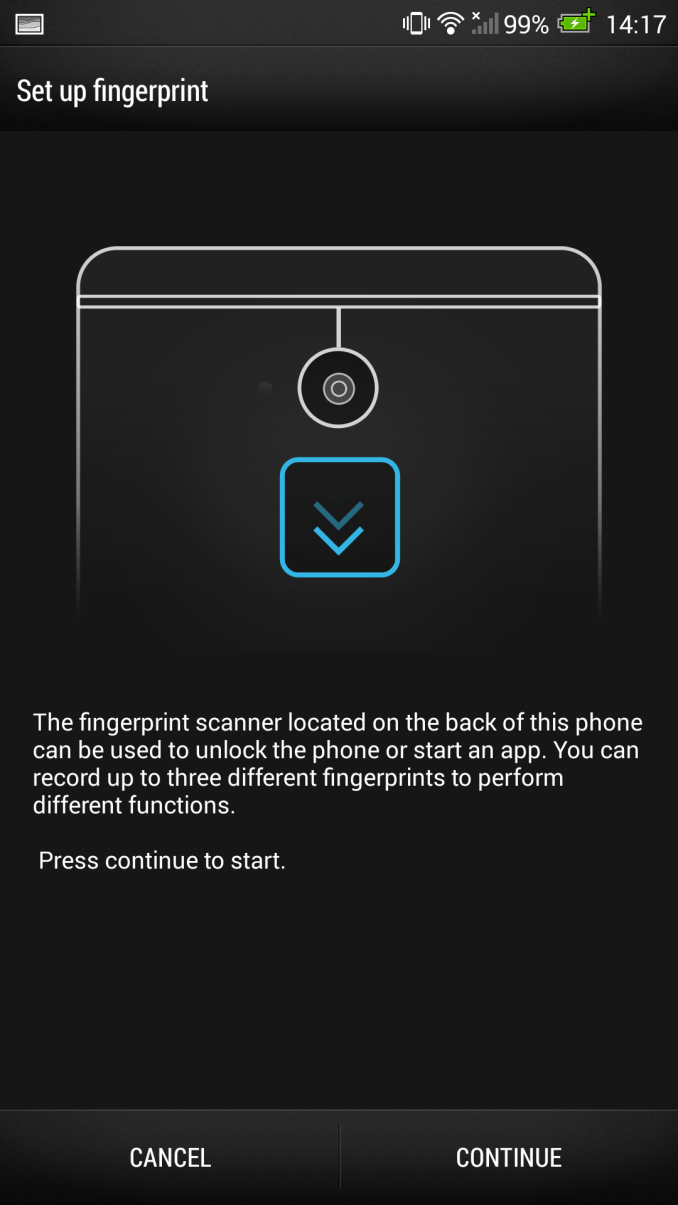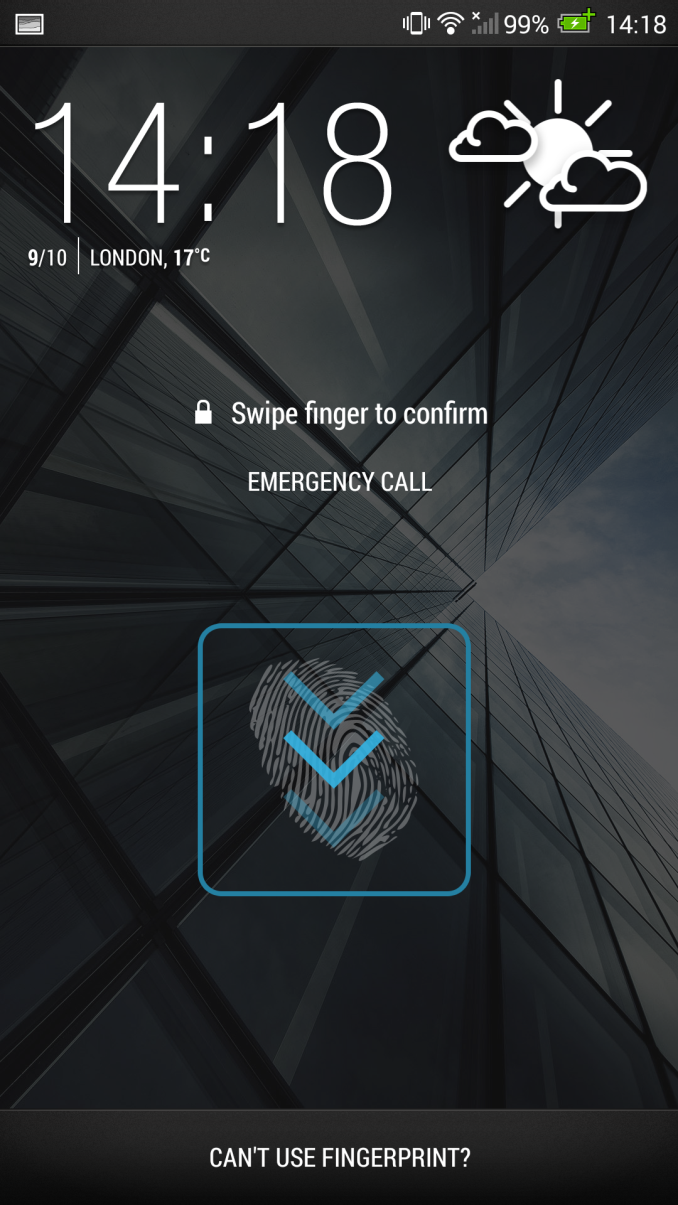HTC One max Review - It's Huge
by Brian Klug on October 28, 2013 10:00 AM EST- Posted in
- Smartphones
- HTC
- Mobile
- One
- Snapdragon 600
- Android 4.3
- One max
The One max joins a small but growing list of phones that include a fingerprint scanner for unlocking the device. I’ll leave the discussion about whether fingerprints are fundamentally usernames or passwords for another day, but fingerprint scanners seem to be in vogue right now for mobile phones. You could make the case that the perceived increase in security that comes with fingerprint scanners is both an enterprise or consumer play, again I’ll leave that philosophical discussion for another day. I remember the Motorola Atrix and its fingerprint scanner being a big deal a while ago, since then we’ve had the iPhone 5s dramatically reintroduce the fingerprint scanner and now the One max follow suit.
The One max fingerprint sensor is a swipe type, meaning there’s some kind of strip sensor inside that you swipe your finger across. Sliding your finger over this strip allows the module to scan a 2D region and extract features that are then used to identify a fingerprint. The One max hides this scanner inside a black square that’s slightly recessed on the back of the device, just beneath the camera. I’m reminded somewhat of the LG G2 and its rear-mounted power and volume buttons which also sit just beneath the rear-facing camera. Perhaps that’s a missed opportunity for LG, which could have also gone with a swipe type sensor in its power button. On the One max anyhow there’s no button, just the sensor. Although the fingerprint sensor is recessed slightly, it’s somewhat difficult to locate with just one’s index finger, something that results in inadvertent smudging of the rear-facing camera cover glass, something that didn’t happen as much with the G2 because there’s a larger lip and easily locatable bump.
The placement of the fingerprint sensor makes sense given that of the power button. As stated earlier for right handed users this means your index finger sits naturally near the sensor if your thumb is on the power button. Since the fingerprint button still requires activation to unlock the One max, you still need to press power to turn it on before you can swipe your finger and finally unlock it. I find myself wishing the fingerprint sensor was itself a button, something like the iPhone 5s, so unlocking could be as simple as pressing and swiping with the same finger. On the iPhone 5s the best activation pattern is pressing the home button and leaving the finger in contact with the button.
Setup requires you to set a passcode, after which a few training swipes trains the sensor for the finger you’ve chosen. Although the animation that plays shows the finger aligned along the long axis of the phone, for greater accuracy I trained the One max with my finger at the angle it would naturally be given my thumb on the power button. The only requirement given the swipe sensor is that the slide motion is straight down and not skewed.
The One max fingerprint sensor allows for up to 3 fingers to be paired, each able to either unlock or have the option of both unlocking and launching an application. I like the idea of fingerprints as shortcuts, something the iPhone 5s implementation lacks, but three fingers seems like a curiously low number given the ten digits humans have to work with. On the other hand, the placement of the button really limits you to middle and index fingers being viable options. In terms of functionality, although Apple doesn’t yet use fingerprints as shortcuts, Apple does use the fingerprint scanner to authenticate iTunes, iBooks, and App Store purchases, something HTC can’t quite do with the One max for Google Play purchases, at least until Google makes an API for it.
I initially trained the fingerprint sensor with my index finger being swiped straight down, and had some issues with unlocks requiring multiple swipes. Doing finger enrollment and training at an angle closer to how I actually swipe it naturally (at an angle) made the accuracy better, but the reality is that unlocking the One max still requires multiple tries more often than not. There isn’t much processing latency after a scan, but I had hoped the One max sensor would be tap and hold rather than swipe given its shape. I’m not clear what suppliers are involved for the sensor, but I’m told the One max also securely stores just the extracted features and not the fingerprint images (which is a no brainer). I haven’t delved much into the infrastructure used to secure the fingerprint features yet either. I’m also not sure whether the One max learns additional parts of the finger which wasn’t part of initial training the same way Apple’s does.
Although I don’t think anyone has totally nailed the fingerprint sensor yet on a device, the One max implementation definitely is further from perfection than Apple’s. Although it does work reasonably well, it still isn’t the transparent kind of convenience that I feel will compel users who ordinarily wouldn’t have to used a passcode to go and use the fingerprint scanner. I’ve continued using the fingerprint scanner on the One max, however.
















197 Comments
View All Comments
rabidkevin - Tuesday, October 29, 2013 - link
What you are missing is that OEM's want internal only storage to CONTROL THE MARKET! Charging premiums on space for outrageous amounts. It has nothing to do with user demand. Why would anyone turn down 32gb of extra space for 30 bucks?I still have a galaxy s2 that I just FINALLY paid off after 2 years. I'm not ready to make payments for 2 more years when I have a perfectly good working phone in my hand.
Black Obsidian - Tuesday, October 29, 2013 - link
You're rabid alright, Kevin.The vast majority of users don't want expandable storage, because the vast majority of users aren't using all of the storage in their (overwhelmingly base-model-storage) phones as it is. Why is this? Well, because the vast majority of users aren't carrying 1,000+ hours of music around with them at all times. Hell, I'd be shocked if the majority of users even HAVE 16GB of music in the first place!
Us geeks aren't the whole smartphone market. Pre-iPhone, we absolutely were. Now? To say we even account for 5% of the overall market would be overly generous, probably by a factor of 10. We're a tiny, TINY fraction of the market, and even then, only *some* of us care about removable storage.
The OEMs might enjoy milking people by charging them $100 for each $20 increment of flash, but relatively few people are bothering to pony up for 32 or 64GB even where it is an option. If you combined all the people who actually use expandable SD *and* all the people who upgrade from base 16GB devices with no expansion, I doubt you'd reach even 10% of the market. Or 5%, for that matter.
(relatively speaking) Nobody cares.
Klug4Pres - Tuesday, October 29, 2013 - link
Brian, some people want removeable SD cards, and what's more the ability to use them is, objectively-speaking, a useful feature with almost no down-side (if we ignore business decisions to economise by reducing internal storage on phones with this feature, and what Google sees as the inability of users to deal with more than one storage location). If the HTC One has a particular design that would be compromised by allowing SD cards, that may be so, but there are other possible designs, and I doubt you could argue that they would be systematically inferior."Being deprecated by a platform" is not a good reason not to support them. Google obviously has a vested interest in tieing people to the Cloud, so we shouldn't care what Google thinks about this.
You have argued, persuasively, that removeable batteries do involve more of a trade-off, but again some people are more than willing to accept that trade-off because of how they wish to use their device, and because they may wish to make use of the device for longer than the expected service life of the battery.
Oh, and I'm calling flamebait on the "going the way of the dodo" comment.
Jedi2155 - Wednesday, October 30, 2013 - link
I take issue with the comment on internal batteries being bigger when sealed in versus removable. In terms of energy I have yet to see this to be true. All the galaxy phones have continued to have removable batteries yet remain in an incredibly small form factor. My Note II has nearly the same energy capacity (~3100 mAh, Note 3 ~3200 mAh), in a smaller and thinner form factor than the 3300 mAh of the HTC One max. I personally believe most of the reason for an internal battery is simply laziness in design. It simply takes a lot more engineering and design work to include a removable battery versus not. I completely believe its possible to cram a removable version of the same 3300 mAh battery in the phone with the volume they had available in this phone. I bet they could have increase the battery volume even further if they put more effort into it.My primary point is that, while going internal does offer some volumetric benefits, majority of the manufacturers do not exploit it for the simple reason that it costs more.
I'm not even going to touch the microSD comment (even while quite possibly true, many geeks and their gf's still demand it).
Steven JW FCK - Monday, October 28, 2013 - link
So what is wrong having "dumb manually managed storage?"It sounds to me like a feature, and a feature I would happily want to have in its usefulness in being partitioned off from the rest of the phone.
And build quality? Really? The way you talk about build quality sounds more like you are interested in how pretty it looks to you and other people? Your hand is supposed to be around the phone when you use it in the first place, so most of this phones plastic surround will be invisible to you and others, so why are so fussy on wanting a pretty phone, over a feature packed phone? Would better build quality translate into better drop-ability? Not at all! That would be an absurd conclusion to blindly believe.
Dentons - Monday, October 28, 2013 - link
But Brian, you don't focus on build quality, not really. Your critique suggests an overwhelming devotion to the fashion of these devices. You're actually neglecting the underlying technology in many cases to focus instead on things one suspects most Anandtech readers could care less about. Honestly? How much time did you devote to the Gold iPhone in a recent podcast? Yes, it's gold, we get it.Carhartt jeans, Toyota Camry's, and Samsung phones all have good build quality. Louis Vuitton, Rolls Royce, and metal skinned phones are almost entirely about fashion. Not the phone's electronics of course, but the metal casing, yes, fashion. You're ignoring the actual technology in favor of focusing, and focusing, and focusing on the minutia of the exquisite metalized skins of these devices.
Metal may often be studier, but that doesn't devolve everything else to crap. That is often the conclusion to be drawn from your criticism. In point of fact, there are plastics with far better strength to weight ratios than any metal. As a technology person, I really don't care if the case is metal or plastic, so long as it's functional. Your endless rants about the greasy Samsung casings truly baffles me. One wonders if you have some sort of unusual oil factories in the palms of your hands?=.
Or just maybe, you go through so many phones that are all so similar, the small differences start to become big differences. In that light, I recommend the following XKCD comic strip: http://xkcd.com/915/ - "Connoisseur"
Brian Klug - Monday, October 28, 2013 - link
Yes I do focus on build quality in the review, and the context is still the tradeoff not being worth it in the case of the One max."neglecting the underlying technology"
What are you even talking about?
-Brian
Dentons - Monday, October 28, 2013 - link
I'm talking about the fact that you rarely, or barely give any kudos to devices with microSD and user swappable batteries. Those features aren't listed as benefits, they're hardly mentioned at all. Anandtech tests everything else, but I cannot recall the last time Anandtech tested the speed of a microSD port.Your recent review of the Note 3 was a case in point. You barely mentioned either of those features. They are real, actual hardware differentiators. For many of us, not only are they important differentiators, the absence of them is a deal breaker.
A cost conscious consumer can honestly want a device to be future proofed for a few years. We don't get new, free, phones a few times each month. Our batteries wear out. Media sizes are ever increasing. Not all of us want to rely, nor can we rely on the cloud for all our media needs. It is a waste for us to spend an extra $200 for a phone with 64GB when we're far better served with $30 in cheap SD storage. As you point out, we cannot use it for apps, it's for video and music. For those use cases, the highest quality NAND is generally wasted.
Even though you don't use those features, the best selling smart phone models in the world still have them. You spend orders of magnitude more time discussing the casings, finishes, and lustrousness of phones than either of those. So yes, in this case, you definitely are neglecting the underlying technology in favor of fashion.
On this topic, in both in your reviews and on the podcast, your attitude is one of "I know what you need better than you know what you need". That's what you're telling us. That you're the expert, and that you know best.
How would you respond to a reviewer repeatedly telling you that you really didn't need the features you used every single day? That's what you're doing. It's annoying, and insulting.
apertotes - Tuesday, October 29, 2013 - link
Well, if they did not neglect those features they would have to criticize Apple for not providing them, and that is a deadly sin.Since Apple is perfection, that is the mirror they use to analyze the rest. Things that do not exist in Apple are worthless by definition.
Dentons - Tuesday, October 29, 2013 - link
You make a relevant point, and allude to another equally important point.As you point out, by not giving kudos to phone makers who include microSD and removable batteries, they don't have to list the absence of those features as cons to the Apple and Nexus products the staff here tend to glow over.
Which leads into another key point. We all know what would happen were Brian's to neglect to mention a key, unique, hardware differentiator in the review of an Apple product. Apple or their marketing agency would contact him. They'd bitch, they'd moan, they'd complain, they may even threaten future review status.
Many reviewers know not to neglect a focus on Apple's little differentiators, but they have little compunction in reviewing 'lesser' devices with a completely different set of rules.